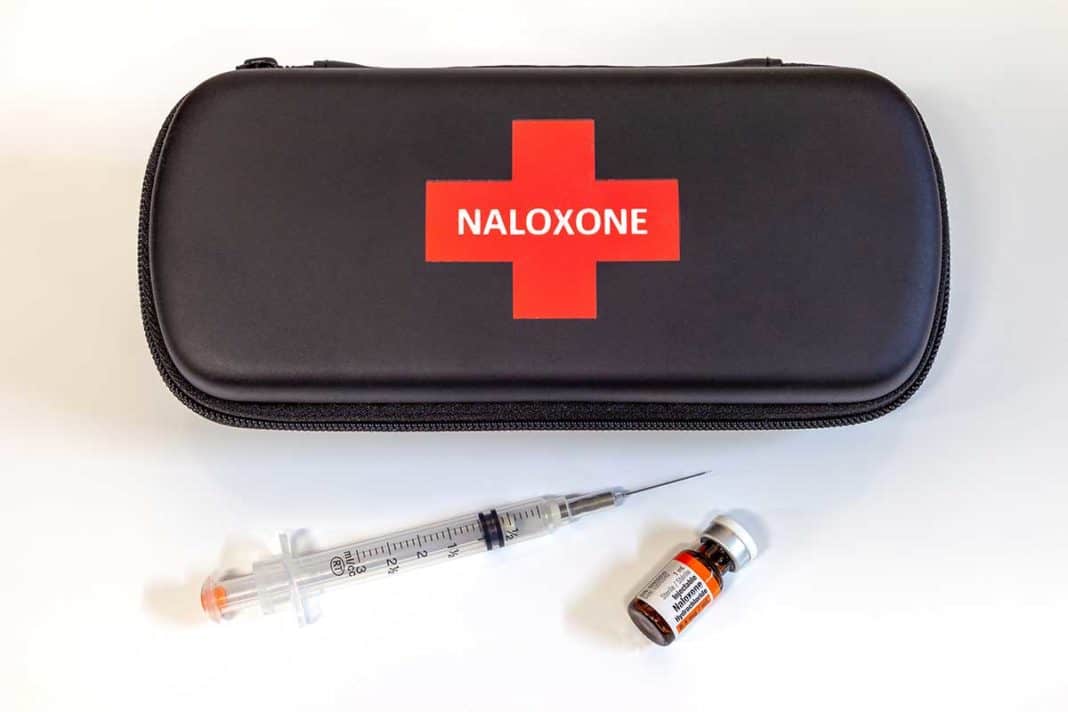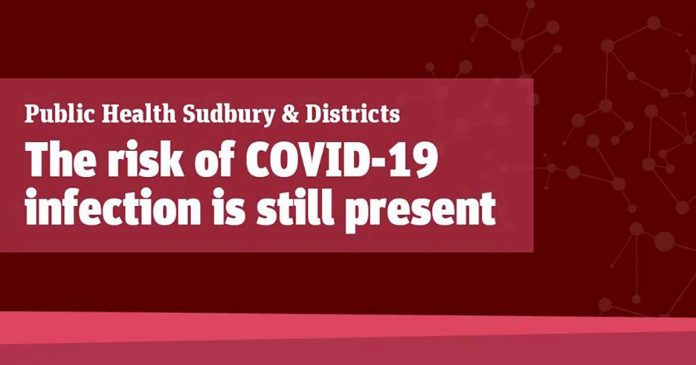M’CHIGEENG – There is another epidemic underway at the same time as the COVID-19 pandemic and that is the ongoing opioid crisis. The growing number of overdoses and deaths caused by opioids is a national public health crisis and Manitoulin Island is not exempt from this trend, said Daughness Migwans, social navigator for the UCCM Anishnaabe Police Service. The opioid epidemic is, in fact, the initial inspiration for a new community safety series of online workshops she is co-ordinating.
“We are partners with the Manitoulin Drug Strategy team,” said Ms. Migwans, “and some of the conversations we have include looking at ways we can provide additional information to the community on different things that may help people who are struggling with mental health and addictions.”
The series of five online Zoom community safety workshops was developed with these concerns in mind. In the first workshop held on Thursday, February 25, Crown Attorney Richard Huneault spoke about the Good Samaritan Drug Overdose Act (GSDOA). “People may be worried about calling for help and getting into trouble,” Ms. Migwans said, noting the Act is intended to reduce the fear of police attending overdose events and encourages people to help save lives during an overdose.
“I can tell you that up until preparing for this topic, the (GSDOA) is not something that I had previously read. The legislation was enacted in May of 2017 so it is quite recent,” said Mr. Huneault. The GSDOA amends the Controlled Drugs and Substances Act (CDSA), which is the offence of simple possession of any simply narcotic.
“What’s interesting about that is there is no case law or court decisions that I’m aware of that have actually dealt with this section directly. Nor is there much literature about how to best interpret how this legislation should be used by police and Crowns. Quite frankly, at this point the legislation raises more questions than it does answers and leaves a lot of room for debate, individual interpretation, argument and discussion.”
Statistics can help us understand what prompted this legislation, said Mr. Huneault. “These statistics apply to the province of Ontario. In the year 2000 there were 111 overdose deaths. Jump forward to 2016 and there were 867 deaths in Ontario. Then in 2019, there were 1,535 overdose related deaths and as of November 2020, in the past three years, overdose deaths have increased by 81 percent. Ninety percent of these deaths are accidental and the majority involve fentanyl, carfentanil and fentanyl analogues. What was clearly happening was that the criminal law was intersecting with this public health crisis. What had become obvious to anybody who was investigating this matter was that a lot of these were going unreported. The government was trying to strike a balance between serving the public interest by encouraging people to report overdoses while at the same time, granting some immunity either to the person that was overdosing or anybody who called for help on their behalf.”
The first subsection defines an overdose as “a physiological event induced by the introduction of a controlled substance into the body of a person that results in a life-threatening situation and that a reasonable person would believe requires emergency medical or law enforcement assistance.” In simple terms, this means that somebody has taken a drug that has caused them to be in considerable distress and there’s every reason to believe that this person needs emergency help, Mr. Huneault explained. The remaining subsections relate to immunity.
Subsection 2 says none of those people who call for medical or police help because they or another person are suffering from an overdose can be charged with an offence of simple possession of a narcotic as a result of what the police might find at the scene of the event. For example, he said, “if police show up for an overdose event and there are fairly minimal amounts of narcotics on the table, everybody who is present at the overdose event when police arrive are not to be charged with any offence related to possession of a narcotic.”
Subsection 3 adds that the exemption applies to any person who is at the scene upon the arrival of emergency assistance. Subsection 4 says that if you’re a person found at the scene of an overdose event or you’re the person who called it in, you are not to be charged with offences such as breaching a bail order that you may be on. “You might be on a curfew, for example, and it’s three o’clock in the morning or you might be on a condition that says don’t possess any drugs but you happen to have some in your pocket,” Mr. Huneault said. “You are not to be charged with breaching either that bail order or any probation order that you might be on with similar types of conditions. The last subsection adds that if a person is on bail release, probation, parole release or conditional sentence order, they are deemed not to have breached any of the terms of any of those orders.”
There are still chargeable offences in an overdose event: the only thing that the people present are immune from are being charged with simple possession of a narcotic or being found in breach of any terms as are related to the overdose event that they’re attending but the information obtained during an overdose event can be used for intelligence gathering or inserted in the grounds for a search warrant in the future.
UCCM Police Constable Bonnie Crowe offered a police perspective. “We’ll get a call which usually comes in as some kind of medical assist or assisting the ambulance. Sometimes it is an overdose and we’re just trying to get there. Our main concern is to preserve life. We do carry the Narcan kits with us and when we get there we don’t ask a lot of questions. We might afterwards, depending on the situation, to see if they want to give us information regarding where the drugs came from. Once again, our concern is to try to take those drugs that are contaminated off the streets. It’s not so much about charging the people at that time. We do collect some of that information which will stay in our system,” she said.
One offence that is not immune in these situations is possession for the purpose of trafficking. “Let’s not forget that in the vast majority of these overdose events, the drug in question was illegally trafficked to the person suffering the overdose,” Mr. Huneault said. “Trafficking includes simply the giving of the narcotic, the bartering or trading of the narcotic for a narcotic and transferring or outright just selling it. For example, if you’re injecting your partner with a substance, that’s a form of trafficking. Police always have to have that in the back of their minds when coming upon a situation like this. What can or can’t they do about it in this situation?”
Somebody who is fully aware of this legislation who does the right thing and calls in an overdose is not likely to talk to police about those details, he added. “It’s very difficult in those situations to conduct an actual criminal investigation because, more often than not, they just can’t collect enough evidence to prove, in the case of a death, where the drug came from and who ultimately administered it, sold it or gave it to the overdosed person. There’s nothing wrong with the police going on scene to figure out what happened and asking questions but the typical scenario is they’re not going to get a lot of answers.” At the end of the day, though, what’s important is saving lives.
“If police are able to figure out who sold the drug or administered it then there are grounds to lay a trafficking charge. If they have that kind of evidence and the victim dies then we’re into Criminal Code offences, potentially as serious as manslaughter but also aggravated assault by endangering life if the person does not die.” If the evidence supports it someone could be charged with production. Related offences where charges can be laid are possession of a prohibited firearm or handguns, possession of an illegal gun or possession of guns without a permit. Other potential charges include administering a noxious substance under the Criminal Code, unlawfully causing bodily harm or aggravate assault.
“When police are responding to a 911 call and it turns out to be an overdose event, they are entering the premises lawfully. If there are drugs or firearms in plain view, it does not give the police carte blanche to do a detailed search of the residence but based on the good old fashioned ‘plain view doctrine,’ as long as they are in the premises lawfully, which they are in responding to an emergency call, police can get the people out of the residence and secure the premises and then obtain a search warrant.”
Along with their partners on the Manitoulin Drug Strategy team, the UCCM Police team headed by Ms. Migwans have created a leaflet and flyer on harm reduction, Naloxone and the GSDOA. “We get feedback that a lot of the time people choose not to call because they’re worried about being in breach or they’ll call and run away leaving that person alone and unattended. Those are the kinds of situations that this piece of legislation is trying to avoid,” she said. “We know it’s not necessarily the people who may be using who are going to read it but we all have family or neighbours or other people in our community that we care about that we can share that information with and depending on the type of work that we do, we can share that information as well.”
Mr. Huneault acknowledged that part of the frustration experienced by police would be that on one hand this legislation gives people some immunity from prosecution but on the other hand police must deal with the victims’ families who want answers and action. “It’s a difficult balance to strike,” he said.
The next event in the series brings Sudbury Rainbow Crime Stoppers to the conversation. “People may have a general reluctance to call police. They don’t want to jeopardize their relationships with their families and neighbours. Crime Stoppers is a service that’s a viable option,” Ms. Migwans said.
“Another big conversation we have internally is what it’s like for people when they have to call 911,” she said. Week three in the series is unique in that it lets participants hear from a call taker/dispatcher from the OPP call centre. “People call our number but might get forwarded to the OPP dispatcher,” said Ms. Migwans. “They’ll always ask why. Why does the dispatcher ask so many questions? Why don’t they just get out here?” The dispatcher will offer some answers for their questions.
Number four in the series looks at harm reduction and overdose prevention with guests from Sudbury’s Résau Access Network. Résau Access addresses mental health and offers timely access to necessary supports and provides harm reduction services, overdose prevention through Naloxone training and distribution as well as education, awareness and prevention as well as other services. This workshop is not just for people with mental health or addiction issues, said Ms. Migwans. It is for anyone who might be affected or who needs to know the signs of crisis, addiction or overdose.
Participants will be introduced to members of the Manitoulin Drug Strategy Team in the final workshop. “A lot of people don’t know what agencies are involved or what kind of services they provide,” explained Ms. Migwans. This workshop will put faces to unknown community helpers and how they provide assistance as well as share how being part of the strategy team supports work being done across the Island.
The workshops are open to anyone who would like to participate. “There’s been a lot of interest from outside of the First Nations communities we service and that’s great,” she said. Wellness takes a community. The series is being held for five Thursdays, beginning February 25 and ending March 25. Workshops start at 12:15 pm and will last approximately one hour each. For further information or to register, send an email to daughness.mmigwans@uccmpolice.com with the subject line: Sign me up for the Zoomies.






